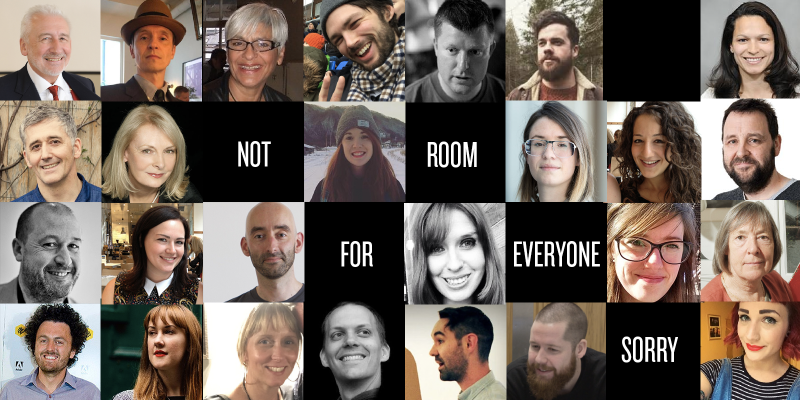Transcript: Hello, I’m sorry I can’t be with you tonight. I wanted to say thank you to Design Week for giving me this award. It’s an honour to be among such great designers.
But I’m not going to talk much about design tonight. So lower your expectations accordingly. I’m going to talk about teams and diversity instead.
Everyone who gets an award thanks their colleagues and mentors. Or their coaches and the left back and the goalkeeper. That’s not just being polite. It’s accurate. Individuals collect awards - but teams win them.
I mostly design for the internet and on the internet there are no lone genius designers.
 (This is just some of the people I have worked with in my career. I obviously couldn't fit everyone in. If you are not here please don't be offended. It's not intentional.)
(This is just some of the people I have worked with in my career. I obviously couldn't fit everyone in. If you are not here please don't be offended. It's not intentional.)
The romance of the lone artisan in their garret coming up with the Big Idea is over.
And I think that’s a good thing. The design industry used to work like this. Back in the 50s and 60s it was more common for designers to work in multidisciplinary teams. They didn’t call it that of course - just worked with whoever they needed to achieve the end product. Names like Margaret Calvert of Kenneth Grange worked with a variety of different skills to achieve great things. This is even more important today. And our job is to make the organisations we work with better at doing that. Better at collaboration.
The toughest design problems in the world today require co-operation at a large scale. They need people with different talents and experiences working together to find answers that work. Design today needs teams that have lots of different perspectives.
That means we need to make it easier for people to become designers.
How I got into design is a really boring story. I studied art and design at school and graphic design at university. I’m sure lots of you did that too. But that’s much harder to do today.
This year is the 180th anniversary of design education in the UK but today it’s possible for schools to get an outstanding grade from Ofsted without teaching any art or design subjects, so 15% of schools have withdrawn arts subjects. And we’re seeing that kids aren’t studying art and design. Entries for GCSE Art & Design down 8% and A-Level 12%. I’m a Governor at University for the Arts London and we’re seeing a drop at Undergraduate Level too. (Stats from NSEAD.)
And Brexit means we’re getting fewer and fewer EU students applying. All at a time when we need designers who reflect who they’re designing for.
You can help by volunteering in an organisation like the Sorrell Foundation’s National Art and Design Saturday Club.
Advocate a career in design to your friends. And your friends’ kids. And then to people who look and sound nothing like you.
 (This is picture of the current UAL Students Union Arts SU. They are a talented, diverse group.)
(This is picture of the current UAL Students Union Arts SU. They are a talented, diverse group.)
Encourage and promote diverse, multi-disciplinary teams.
A hard problem, but a useful one to solve - because that’s what designers do best. If it's easy, make it look easy. If it isn't actually easy, then make it easy. Thank you, enjoy the rest of your evening.
(Huge thanks to Ella who helped write the speech. She is available to help you too.)

Comments